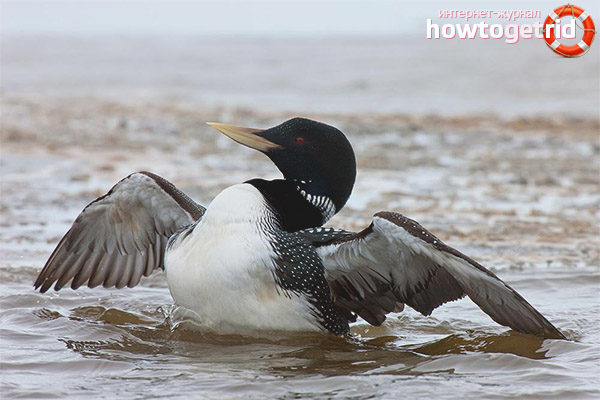The content of the article
The loons are waterfowl, primarily found in northern Eurasia and North America. The order includes only 5 species, one of which is the white-billed loon.
Appearance
A distinctive feature of white-billed loons is the sharp beak slightly raised to the top. The head and back of these birds are black, with large white spots. The belly is white. On the neck and wings there are characteristic white stripes that distinguish them from other species.
White-billed loons are also the largest representatives of their squad - their body weight varies on average from 4 to 6.5 kilograms, and the length can reach 70 centimeters. The sizes of these birds can be compared with the sizes of domestic ducks.
Due to the fact that birds live in the cold northern waters, their plumage is distinguished by its density and density. And on their paws they have membranes that allow them to dive to a depth of 20 meters and swim perfectly.
However, the loons are not at all adapted to life on land. They start flying with water, and also land in water. The fact is that their paws are arranged in such a way that they can break due to landing on land.
Habitat
The nests of white-headed loons are uncomplicated. As a rule, they are lined with the remnants of dry grass, right on the shore of the reservoir. In order to easily get into the water from the nest, the loons dig small trenches, through which you can easily slide down and rise back.
Breeding
Birds live in small flocks, each of which numbers from 3 to 6 individuals. The loon is called monogamous birds. For life they find only one partner, with which they take out the chicks and fly from place to place. Their puberty occurs relatively late - by about 3 years.
Offspring are usually hatched in late July or early August. In most cases, there are only two eggs in a clutch. By coloring, the eggs are brown, with a black speck, rather large and slightly oblong. The hatching period lasts an average of 30 days. During this time, the male and female take turns hatching offspring and do not leave the nest. Seeing the danger nearby, the bird descends from the nest into the water and begins to scream and beat its wings on the water in order to attract the attention of the predator to itself, and not to the eggs lying in the nest.
Chicks are particularly independent: they can leave the nest the very next day after their appearance, they can immediately swim. They are covered with a thick downy layer of dark gray color. The parents feed the first 2 weeks of life, and then the chicks begin to feed on their own. By 8 weeks of life, the chicks learn to fly, and by 11 weeks they are already becoming completely independent of their parents.
The character of the white-headed loon

The loons are distinguished by their caution, but do not have special maneuverability, so in case of danger they dive under water, where they can be up to two minutes.
In preparation for the flight, the loons emit a characteristic cry. And when a predator approaches, they start screaming, but in nature the loons have few "enemies", so birds rarely cry. Natural danger to birds is created by foxes, gulls, arctic foxes and skuas.
The life of a bird lasts up to 20 years and all this time they are very constant in choosing a place of residence: even during flights, the loons tend to the same reservoirs.
Food
The diet of birds is based on small fish, crustaceans and mollusks. If necessary, they can eat everything that is found next to the nest. In addition to fish, it can be insects and worms. Sometimes the loons even feed on plants. In general, with regard to food, the bird is unpretentious.
Interesting Facts
- White-billed loon is listed in the Red Book. Previously, hunting for this bird was very common. Ladies' hats were made from their skins; there was even a fishing for loon, which was called "bird fur." Over time, the popularity of products made from their fur and feathers has passed, however, the population of these birds has suffered greatly as a result of such interventions. Now the white-headed loon is listed in the Red Book of the Russian Federation.
- Loon scream. The shout of the loon can be compared to the howl of some wild beast. Moreover, males cry most often, females make loud noises only during the mating season.
- The loons cannot get along with a person. The loon cannot be tamed. Having met a person near his nest, a bird can leave him forever, even if there is a laying of her eggs in it. Because of this feature, the existence of bird farms on which the loon is bred is not possible.
Video: white loon (Gavia adamsii)










Submit